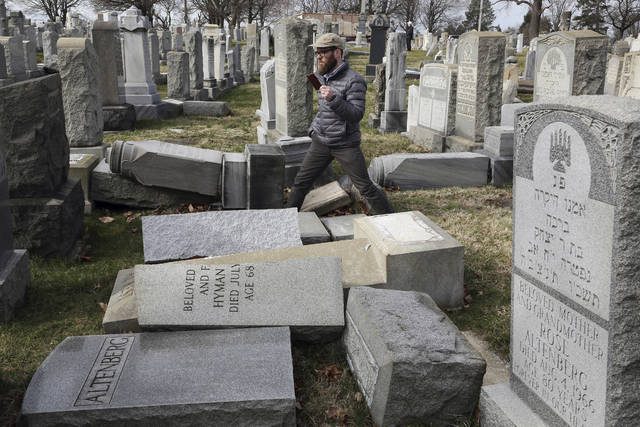Anti-Semitic incidents were on the rise even before shooting

NEW YORK — Swastikas scrawled into Jewish students’ notebooks. Headstones toppled and desecrated by vandals at Jewish cemeteries. Jews falsely blamed for challenges facing the nation.
NEW YORK — Swastikas scrawled into Jewish students’ notebooks. Headstones toppled and desecrated by vandals at Jewish cemeteries. Jews falsely blamed for challenges facing the nation.
The shooting rampage that killed 11 people at Pittsburgh’s Tree of Life Synagogue on Saturday is being decried as the deadliest attack on Jews in U.S. history, allegedly carried out by a virulently anti-Semitic gunman. The carnage, however unprecedented, is not an aberration.
Year after year, decade after decade, anti-Semitism proves to be among the most entrenched and pervasive forms of hatred and bigotry in the United States.
Jews make up only about 2 percent of the U.S. population, but in annual FBI data they repeatedly account for more than half of the Americans targeted by hate crimes committed due to religious bias. The Anti-Defamation League identified 1,986 anti-Semitic incidents in the U.S. in 2017, up from 1,267 in 2016, and also reported a major increase in anti-Semitic online harassment.
Anti-Semitism surfaces often in the research conducted by the Southern Poverty Law Center, which tracks various U.S. hate groups, including neo-Nazis, white nationalists, skinheads and others.
“They’re all anti-Semites — that’s the tie that binds them,” said Heidi Beirich, director of the center’s Intelligence Project. “They believe Jews are pulling the strings behind bad things happening in this country.”
Of the thousands of anti-Semitic incidents in the U.S. in recent decades, only a handful were deadly. Among the most recent:
—In June 2009, a gunman who had anti-Semitic writings in his car killed a security guard while trying to enter the U.S. Holocaust Memorial Museum.
—In April 2014, Frazier Glenn Miller Jr. fatally shot a 69-year-old man and his 14-year-old grandson at a Jewish community center in suburban Kansas City, then killed a woman at the nearby Village Shalom retirement center.
Long before those incidents, many synagogues and Jewish organizations in the U.S. had been ramping up security measures.
Fifteen years ago, the Anti-Defamation League issued a 132-page guidebook titled, “Protecting Your Jewish Institution: Security Strategies for Today’s Dangerous World.”
It includes detailed advice on controlling access to the premises, and also urged leaders of institutions to think carefully about whether or not they wanted to hire armed guards.
After hearing news of the Pittsburgh shooting, President Donald Trump speculated that the death toll would have been smaller if an armed guard had been in the building.
Stephen Cohen, a co-president of one of the congregations that used the Tree of Life Synagogue, said leaders of the facility had conducted active shooter drills in the past, and considered themselves well-trained in how to handle security crises. However, a rabbi-emeritus at the synagogue, Alvin Berkun, said guards — while used during the major Jewish holy days — were not on duty Saturday.
Many U.S. synagogues do employ armed guards; others have taken alternative measures to tighten security.
“I doubt there’s a synagogue in the US that doesn’t think seriously about security,” said Beirich of the Southern Poverty Law Center. “It’s really sad that you can’t go to a house of worship without thinking you’re taking your life in your hands.”
Anti-Semitism has deep roots in many places far from the U.S., including Western Europe.
In Germany, which recorded 1,453 anti-Semitic incidents in 2017, police officers are often stationed outside synagogues and other Jewish institutions. Similarly in France, where anti-Semitic violence increased by 25 percent last year, police and military patrols are deployed to help protect synagogues.
Matthew Berger of Hillel International, a worldwide Jewish student organization, said there has been an increased focus on security in recent years.
“By and large, we want to be an open and engaging community,” he said. “We work tirelessly to balance that desire to be available and open with the security needs of our community.”
According to the Anti-Defamation League, anti-Semitic incidents on college and university campuses in the U.S. nearly doubled in 2017, rising to 204 from 108 in 2016. At K-12 schools, 457 anti-Semitic incidents were reported, including swastika graffiti and playground bullying.
In a separate report, released last week, the ADL said far-right extremists have ramped up an intimidating wave of anti-Semitic online harassment against Jewish journalists, political candidates and others ahead of the Nov. 6 midterm elections.
ADL researchers analyzed more than 7.5 million Twitter messages from Aug. 31 to Sept. 17 and found nearly 30 percent of the accounts repeatedly tweeting derogatory terms about Jews appeared to be automated bots. But accounts controlled by real-life humans often mount the most “worrisome and harmful” anti-Semitic attacks, sometimes orchestrated by leaders of neo-Nazi or white nationalist groups, the researchers said.


